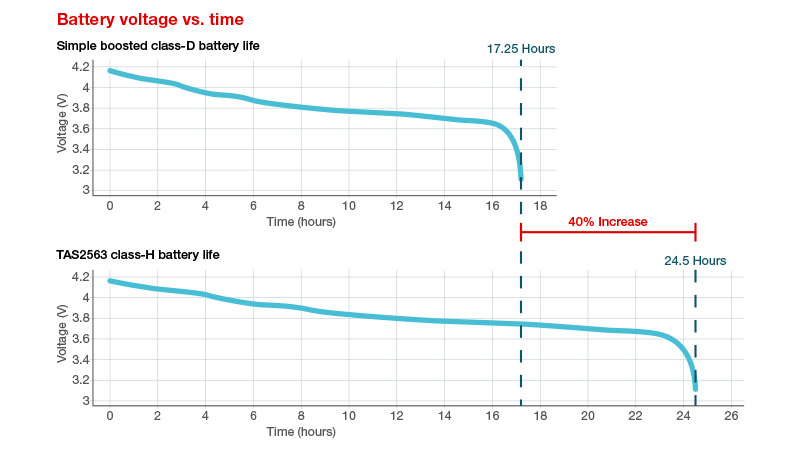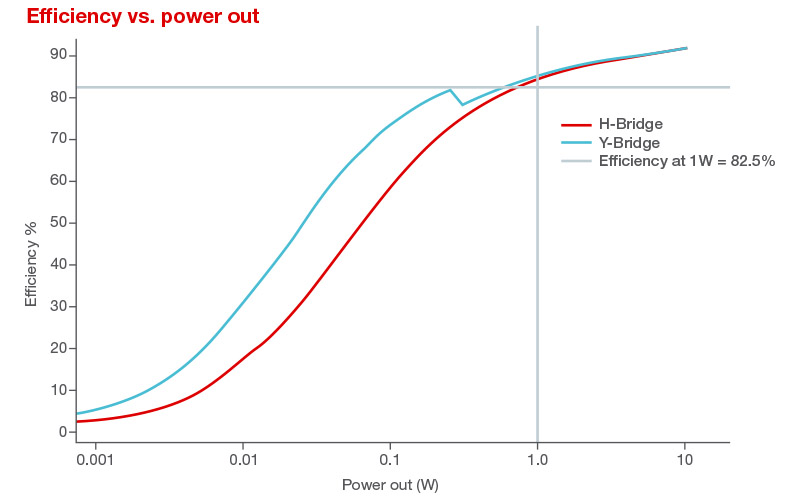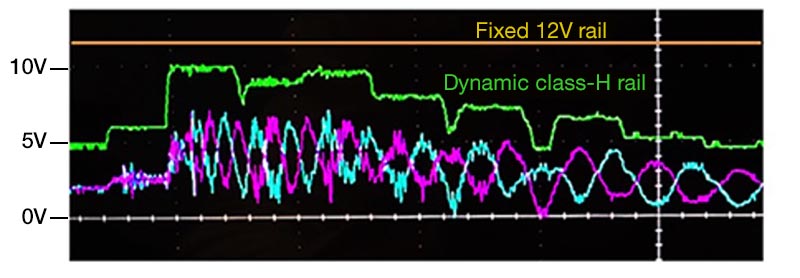SSZT213 December 2020 TAS2563 , TAS2764 , TAS5825P
Battery-powered audio system designers seek to achieve two goals: extending playback time and reducing cost. Older, conventional Class-D amplifiers, while reliable, have been part of this challenge because they consume too much power for portable systems.
Digital-input Class-D amplifiers have delivered audio in television sets for a decade. The problem with amplifiers designed for TVs is that they are not designed to save power. They are designed to be 85% efficient at full power, which is typically around 24 V. Most portable systems and smart speakers operate at half that voltage, reducing operational efficiency to around 60%. This means that 40% of the voltage sent from the battery to the amplifier never makes a sound. Put another way, the amplifier wastes nearly 20% to 40% of the battery as heat.
If you have a line-powered smart speaker, an inefficient amplifier could significantly increase the ambient internal temperature, even when idle. Excessive heat can make cases warm to the touch, which could shorten the life of other components, leading to premature system failures and returned products – both of which can damage the manufacturer’s reputation with their customers.
The core issue of efficiently converting chemical energy stored in the battery to acoustic energy from the speakers centers on managing the voltage demand of the output signal. Fix that, and battery life improves. Many designers of battery-powered audio systems want multiple, affordable ways to better manage the energy demand from the amplifier. At TI, we’ve learned that no single approach addresses all battery-powered systems, so our new audio amplifiers have three different ways to reduce power consumption:
- Internal Class-H boost
control. The best option for 10-W battery-powered systems with a 1S
battery is an amplifier that includes an integrated look ahead Class-H boost
that is controlled by algorithms. The amplifier directly connects to the
battery; the algorithms interpret the output signal and controls the boost
to provide only the voltage necessary. The look-ahead processing matches the
power consumption to the audio output by constantly analyzing the audio
signal and keeping the power within a small envelope of power use, then
managing the boost output. This envelope-tracking approach reduces audio
power consumption as much as 40%. Think of it like cruise control for the
boost.
Tests conducted by TI, summarized in Figure 1, show that this approach can extend battery life by 40%. Learn more about Class-H boost control in the application note, "Benefits of Class-G and Class-H Boost in Audio Amplifiers."
 Figure 1 Class-H boost battery life
comparison
Figure 1 Class-H boost battery life
comparison
- Y-bridge multilevel
voltage input.A Y-bridge input is great for devices with long idle
periods, like smart speakers. Most of the day they are idle, but the
amplifier still draws power. A Y-bridge multilevel input draws power from a
3-V rail while idle, then dynamically switches to the high-voltage rail when
necessary. Figure 2 graphically shows the higher efficiency while running at
lower voltages. The connections are simple and the amplifier does the
switching dynamically, without the need for software or external control.
- Y-Bridge is an innovation that makes it possible to simultaneously connect an amplifier to a high and low voltage input. For example, the amplifier could connect to 3.3-V regulated rail and a 15-V regulated rail. The amplifier dynamically shifts between the high and low rails based on the power needed to deliver the necessary output level. Assuming all the rest of the system power is the same, then the Y-Bridge will consume at least 80% less power while idling while providing all the power needed during operation. Learn more about the TAS2764 audio amplifier with Y-Bridge architecture.
 Figure 2 Higher efficiency at low power
levels and in standby mode
Figure 2 Higher efficiency at low power
levels and in standby mode- Hybrid-pro external Class-H boost control. For systems with higher output needs, like large Bluetooth® speakers and smart speakers, TI’s hybrid-pro external Class-H control algorithm continuously analyzes the audio signal and provides feedback to an external DC/DC converter to increase the voltage for the amplifier when necessary. This lowers the voltage when playing at lower volumes or when a lower output is required. Figure 3 shows this dynamic process in action, showing the changing voltage as the audio signal fluctuates Compared to a typical amplifier, hybrid-pro mode can increase battery life by over 20%. Learn more in the technical article, "How audio amplifiers with integrated DSPs are increasing efficiency."
 Figure 3 External Class-H hybrid-pro
boost control
Figure 3 External Class-H hybrid-pro
boost controlBattery-powered systems and smart speakers have unique power requirements, but both need better efficiency than what conventional Class-D amplifiers can provide. TI’s portfolio of digital-input amplifiers can help you improve playback time and control cost while maintaining premium sound.
Additional resources
- Learn more about TI’s audio amplifier technologies.
- Explore the TAS2563 Smart Amplifier.
- Read the technical article, "How a look-ahead boost conquers battery-life challenges in speakers."